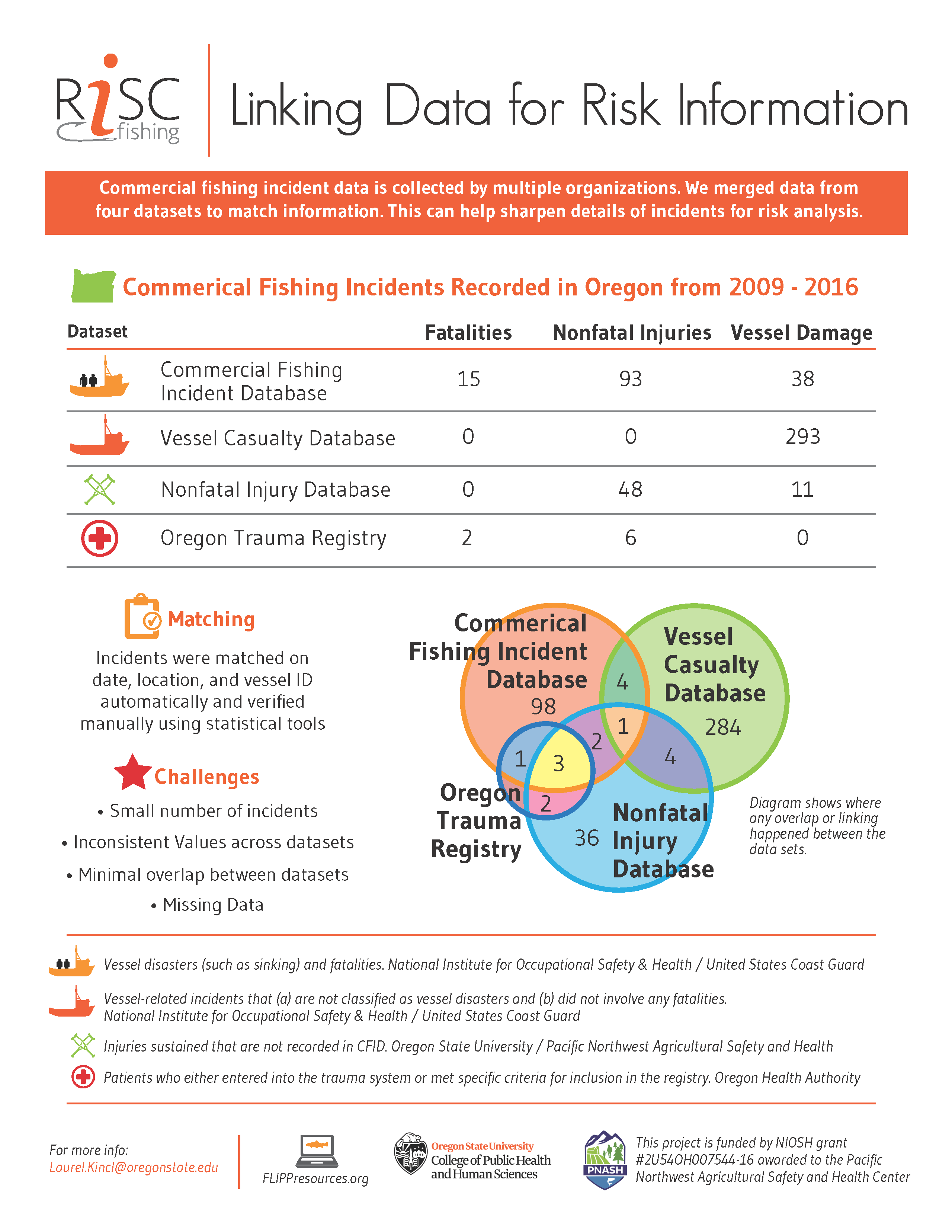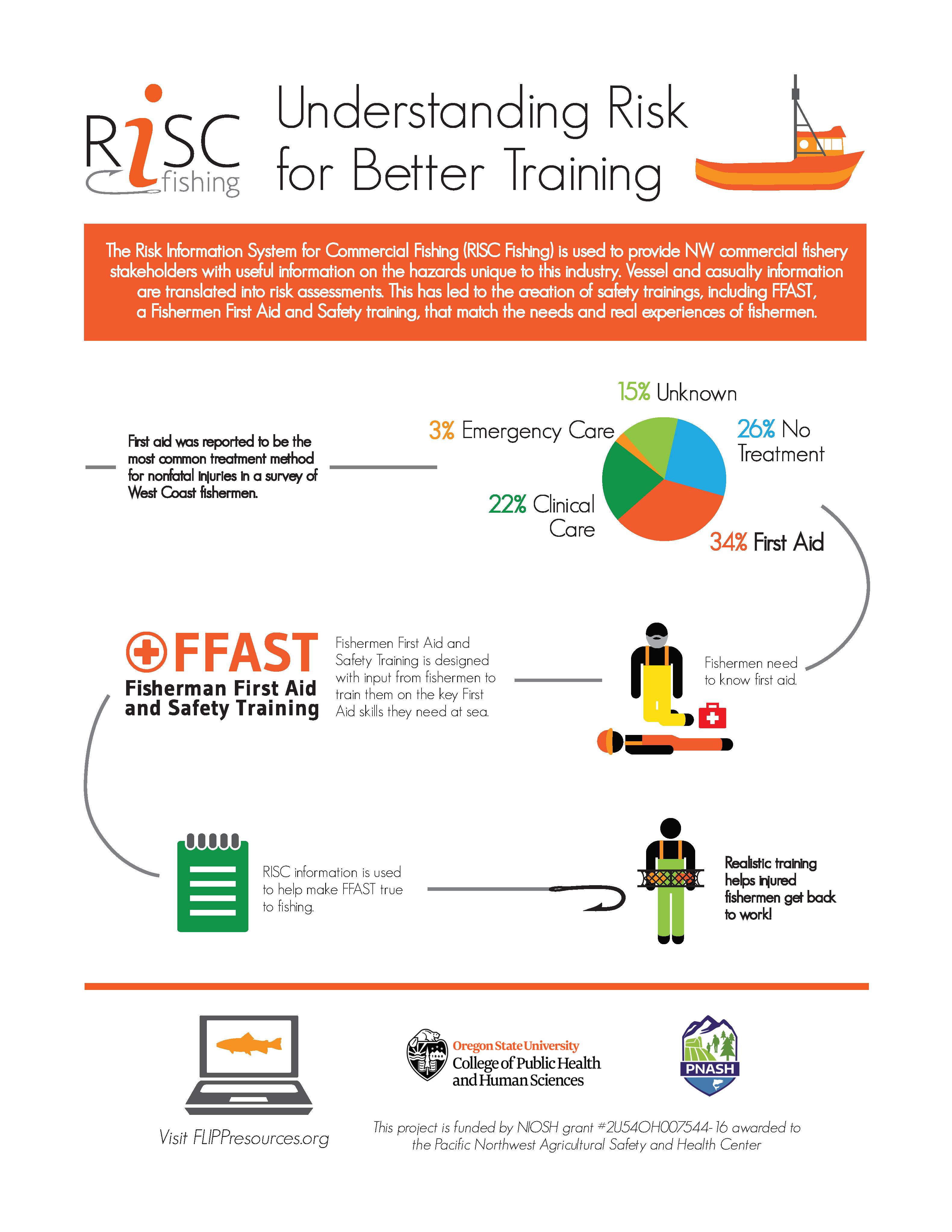Principal Investigator: Laurel Kincl, PhD, MS, Associate Professor, Environmental and Occupational Health, Oregon State University
NIOSH 1996-2022
Commercial fishing is vital to Pacific Northwest economies and communities. Compared to other industries, it is one of the most hazardous due to higher rates of serious injuries and deaths. There is a need for risk information systems to identify the causal factors of these injuries to better inform and evaluate prevention solutions.
Project Overview
This comprehensive data project, RISC Fishing, used multiple datasets to estimate injury risk and risk factors for Pacific Northwest commercial fishing. Our goal was to work in partnership with fisheries to pinpoint and address hazards. RISC Fishing developed a new Commercial Fishing Incident Database (CFID) to provide routine, accurate, and automated data linkage that is currently in use by NIOSH and industry partners.
Findings to Date
- Analysis of 245 nonfatal commercial fishing injuries in the Pacific Northwest (2000- 2018), identified the top three injury events: Contact with objects (108 events). Fishing gear (40%) was the dominant injury source, most often due to hauling the fishing gear (22%). Handling heavy loads (32%) and contact with unsecured objects (27%) often resulted in injuries. Transportation (58 events). Most often occurred in the catcher-vessels (93%) and smaller vessels (< 5 crew) (74%). Vessel casualties (91%) were common and often due to striking rocks/bottom (29%) or fire and explosion (19%). Crew abandoned to water (38%) due to no life raft or raft malfunctions. Slip, trip, and fall injuries (43 events) typically happened with onboard traffic (49%). Such events were largely experienced by the catcher-processors (44%) including large vessels with >100 crew (28%).
- Analysis of 93 commercial fishing fatalities found that vessel casualties were the most common incident (67%). Falls overboard (20%) most commonly occurred with deckhands (71%) and in the Dungeness crab fishery (41%). The two main causes were slips and trips (35%) and being knocked by gear or gear entanglements (29%). None of the fall-overboard victims were wearing PFDs.
Other Accomplishments
- Successful completion of the CFID 2.0 and continues to be managed by the NIOSH Western States Division.
- 16 outreach products and 3 trade articles. Products included Hazard Sheets, Placemats and RISC Fishing Findings were developed to promote injury prevention.
- A publicly available interactive injury data visualization tool, RISC Commercial Fishing Injury Data Visualization. Users can explore trends by state, injury event, source of injury, fishery and gear type.
- In 2022 our ‘Fishing Fridays’ shared RISC findings and resources for mental health. In total 24 social media posts were developed reaching 814 people.
- The Haddon matrix analyses used were constructive to identify potential nonfatal injury-associated factors.
- An evaluation of state trauma registry data showed that state trauma system data may be of limited utility in identifying commercial fishing injury incidents but may be more useful in identifying farming or logging incidents.
- RISC Fishing partners with the CDC/NIOSH Commercial Fishing Safety Program and was guided by a Technical Advisory Board (TAB), including the United States Coast Guard, Washington and Oregon fisheries management professionals, the Oregon Health Authority, the National Oceanic and Atmospheric Association, the Alaska Marine Safety Education Association (AMSEA), health and safety professionals, and Sea Grant commercial fishing extension agents. An evaluation of the TAB demonstrated the strength of their contributions toward the project and reciprocal benefits to their programs.
Next Steps
Dissemination will continue to take place regionally at dockside exams, commodity meetings, first aid and safety training, social media, and through Oregon Sea Grant. Through PNASH's new 5-year RISC project, we will continue CFID’s detailed analyses, interpret the result with fishing stakeholders, and continue to improve the system in collaboration with our partners.
Training
- FLIPP Resources for Commercial Fishermen | Oregon State University
- FFAST – Fishermen First Aid and Safety Training | Oregon State University
Partners and Advisories
- NIOSH Western States Division
- Oregon Trauma Registry
- U.S. Coast Guard
- Alaska Marine Safety Education Association
- Marine and Environmental Research and Training Station
Resources
RISC – Risk Information System for Commercial Fishing | Oregon State University
Commercial Fishing Injury Data Visualization | RISC Fishing | Oregon State University
Vaughan A, Bovbjerg V, Doza S, Kincl L. Evaluation of a Technical Advisory Board for an Occupational Injury Surveillance Research Project: A Qualitative Study. Health Science Reports. 2022 Aug 8;5(5):e777.
Doza S, Bovbjerg VE, Vaughan A, Nahorniak JS, Case S, Kincl LD. Health-Related Exposures and Conditions among US Fishermen. Journal of Agromedicine. 2022 Jul;27(3):284-291.
Nahorniak J, Bovbjerg V, Case S, Kincl L. Application of Data Linkage Techniques to Pacific Northwest Commercial Fishing Injury and Fatality Data. Injury Epidemiology. 2021 Jul 5;8(1):26.
Findings as reported at the end of year five are included in our annual report.
These project resources use risk information on the hazards unique to the industry to provide commercial fishery stakeholders with guidance and tools.



